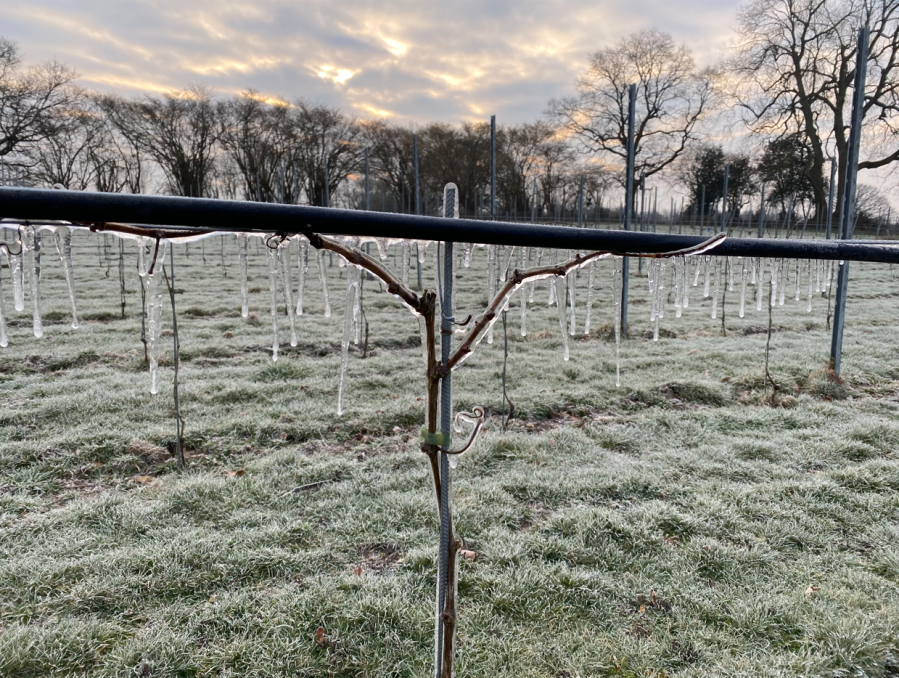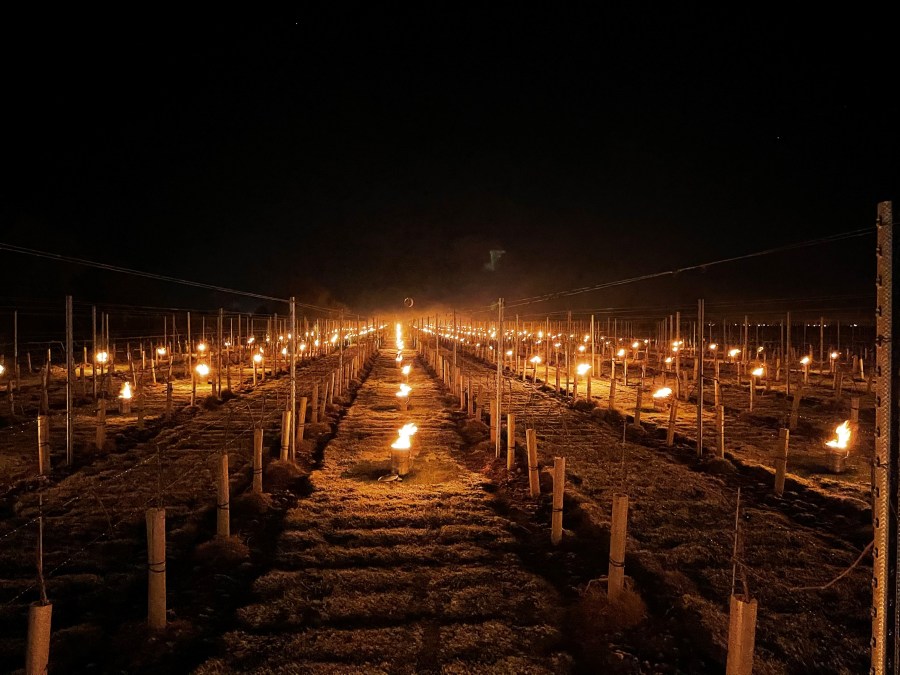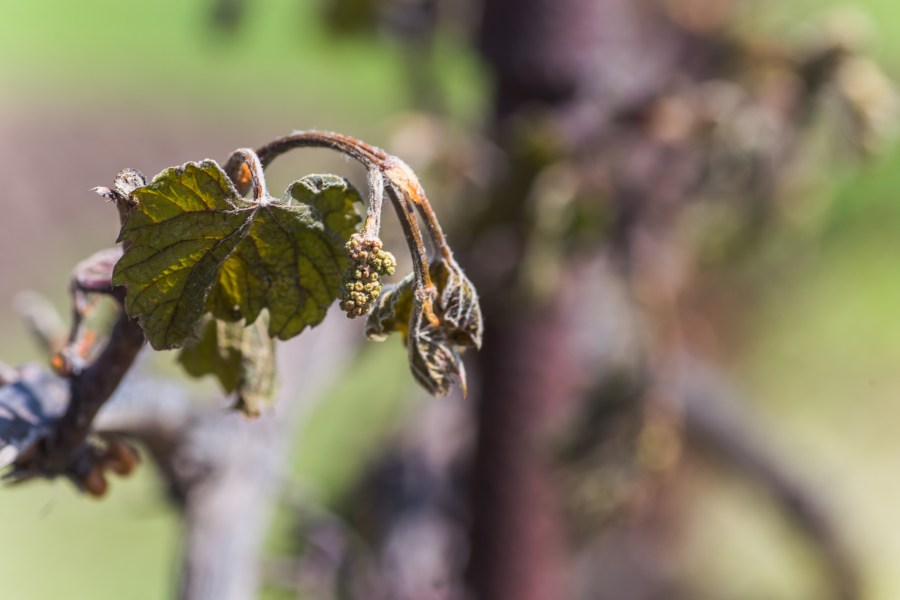Thanks to climate change, average growing season temperatures are on the rise in the UK, leading to earlier budburst. Accordingly, the risk from early season frost is significant and unpredictable from year to year.
When planning for variable conditions, it is important to know your enemy. This is particularly true when it comes to understanding frost and the threat it poses to new growth in your vineyard.
“Frost can completely devastate the crop. It’s something I’m always paranoid about because it is so labour intensive,” says Director of Enborne Vineyard Mark Darley. “I start to lose sleep in January about losing sleep in April and May having to go out frost fighting.”
France’s agricultural ministry reported a 29% plummet in wine production across the country in 2021 after sustained frost events along with hail and disease took their toll on grape growers nationwide. To combat effectively we need understand the different types of frost and how they cause damage.
Radiation frost
When the nights are clear and calm, radiation frost is the enemy. As the sky is colder, the ground’s warmth is transferred upwards. Very cold air settles close to the ground, particularly in any available dips in the terrain, with an inversion layer of less dense, warmer air above. This inversion layer is utilised by a number of frost protection techniques to mitigate against damage.
Humidity also offers a degree of protection from radiation frost damage. High levels of humidity in the air causes white frost on the vines. Temperatures remain close to zero and although the vine is covered in a white coat or even ice, this may actually protect the buds. Soil moisture can also help to absorb and store heat during the day, reducing the risks at night
Advection frost
On cloudy, windy nights, advection frost is the foe. A large mass of cold air is moved in by strong winds and surrounds the vines. The temperature may dip well below 0°C and stay there into daylight hours.
Active frost protection measures rarely guard against this type of frost because of the strong winds and lack of an available source of warmer air.
How frost causes damage
Frost damages new growth when osmotic dehydration compromises the cell’s structure, or the cell wall is burst by expanding ice crystals. The amount of damage sustained depends very much on the stage of development that the buds have reached. Dormant buds are able to tolerate very low temperatures as they have been isolated from the plant’s vascular system. They contain little water and little free space for ice crystals to form that might damage the tissue.
Once the vines are triggered to wake from their winter dormancy by prolonged periods of higher temperatures, the buds are reconnected to the vascular system and the primary buds begin to grow. As scaly buds grow, they become less dense and contain more water, so they can easily take damage in freezing temperatures. As shoots and leaves unfurl, the plant becomes even more susceptible to frost.
“The average worst temperature in this country is about minus 12°C to 14°C,” says Vine Works’ Senior Viticulturalist, Charles Martin. “At the scaly bud stage, in those temperatures, you could lose about 50% of your crop. Then, when you have green shoots with leaves beginning to show, you can start to have an effect from the frost at just minus 2°C, so it changes dramatically as the vines develop. The trouble with the late frosts in May is that you have shoots of three or four inches long, and it’s very hard to protect those.”
Secondary and tertiary buds are contained within the bud structure, waiting to replace the primary if it is damaged. However, a shoot growing from a secondary bud may or may not bear fruit. Secondary buds will only sprout a maximum of one inflorescence so yield will certainly be reduced if primary buds are compromised. Regardless, the time lost when the primary buds are damaged may mean that a secondary crop does not have the time to ripen properly.
Frost damage is not always immediately visible. Young green shoots may wilt, but older, more hardened shoots may not show damage for several days. Where late frosts catch inflorescences, this too may not be seen until a few days later when they dry out and the individual flowers start to fall off.
Frost mitigation measures
Mitigating the effect of frost begins with careful planning of a vineyard to enhance the amount of heat retained by the soil and minimise the amount of time that vines are exposed to lower temperatures. Site selection, trellis design and soil management all have a role to play here.
Forewarned is forearmed. A good weather station that records the frost will give you the data needed to map where it occurs and the opportunity to plan how you will react to it. Having an accurate wet bulb temperature also helps to anticipate frost in the moment. Mark Darley, Director at Enborne Vineyards, thinks that thermal imaging drones are the next step for larger vineyards to accurately map the exact location of cold pockets during the night so that costly mitigation measures can be focused during a frost incident.
Passive measures
Charles Martin at vineyard managers Vine Works is an advocate for natural methods of frost mitigation – planting on slopes where frost can drain away and avoiding pockets where frost will naturally collect. Varieties can play an important role too – Pinot Meunier buds later and is a stronger vine, so that can be a good choice for frost-prone areas of the vineyard.
“The effects of frost can be huge, “ Charles says. “I’ve seen frost travel down a road. Somebody had left the gate open and the frost went down through the gateway and into the vineyard. You could see where the frost affected the plants. It always follows that easy path so it’s worthwhile doing what you can to channel the frost.
“Remove all the trees and scrub from the lowest part of your vineyard, so the frost can funnel away without being impeded. If you’ve got an advection frost, the cold winds come in from the north so if you put in a tree barrier that can help to divert it a bit. Then when the frost comes in, drink a glass of whiskey and wait for it to pass.”
One of the most straightforward practical measures you can take in an established vineyard is to prune accordingly in frost prone areas. As vines have apical dominance – the buds furthest away from the trunk will grow first – pruning late in the Spring can help delay the growth of the buds you wish to protect. Double pruning or using the ‘sacrificial cane’ technique can also help to delay the growth of your chosen primary buds until after the frost risk has passed.
Wind machines
The Tow & Blow is a portable wind machine developed in New Zealand. It captures the heat rising from the soil and blows it back over the vines, stopping ground temperatures from decreasing to a point where frost can form. It can be angled to give flexibility for vines planted on a range of elevations. The Tow & Blow is distributed in the UK by Vitifruit Equipment.
“Being a mobile frost protection, it can be moved to wherever you need it to be effective,” Vitifruit’s Managing Director Richard Whitt tells me. “It’s very easy to set up and it runs independently, so it doesn’t need to be connected to an electricity supply. The machine can be pre-programmed to come on at a certain temperature so that it can be left unattended overnight.” Depending on the contours of the land, the smaller model, the Tow & Blow 250h can protect around three to four hectares, while the larger model, the 650i, works to a radius of around five hectares.
Irrigation systems
Irrigation as a frost mitigation measure protects against both advection and radiation frost, at perhaps the lowest temperatures of any measure, down to minus 8°C. As the temperature of the water being sprayed is higher than the air and the vine, it creates a warmer microclimate. The water creates a thin layer of ice around the plant, and as the water freezes, latent heat is released.
As long as the water is continuously applied, this process continues, preventing the bud from reaching the damaging low temperature of the air.
“The benefits of the Plantex 360 automation include targeting specific areas of the vineyard which are affected differently by frost,” Ewan Worsley, Plantex’s Managing Director, explains. Plantext UK are a provider of technical irrigation solutions across a range of industries, with particular expertise in vineyards.
“In-field sensors mean your specified temperature and humidity level is automatically detected, giving you peace of mind that your water and energy usage is as minimal as possible,” Ewan continues. The sprinklers and control system have a long life span and can be integrated with a drip irrigation system to irrigate and fertigate your vineyard.

Bougie Candles
Lighting small bonfires, and then oil-filled smudge pots, to ward off unexpected frosts is a long-standing method of active frost fighting. Stopgel has been synonymous with the production of modern anti-frost candles since 1995.
“We were originally, and still are, grape growers and famers ourselves and we started making this product to answer our own needs” Cédric Chazalet explains. “The candles we put on the market are the same candles we use to protect our own crops. Stopgel actually translates in English as ‘to stop frost.’
“Thanks to this we improved the candles on two key points,” Cédric continues. “First, Stopgel Green candles have very low smoke emissions compared to petroleum-based candles for more responsible protection of vineyards and orchards. Second, and this is perhaps the most important, thanks to a raw material which is unique to our products, Stopgel Green candles perform better as they have a significantly higher calorific value per hour than petroleum candles. Additionally to this, each candle has a serial number for extra quality assurance.”
Stopgel Green candles are contained within in stackable metal buckets and burn for up to eight hours. They use a unique natural and renewable stearin “wax” that produces 50% more energy than a paraffin or petroleum candle and emits much less smoke. It is also a biodegradable product. Two hundred candles per hectare are required at minus 2°C, and by increasing the numbers used, they can be effective down to minus 7°C.
Tim Jeffs, Founder of The Crop Candle Company worked with Sustainable Wines of Great Britain to come up with something that was more eco-friendly and more economical than traditional paraffin candles. They offer a 100% vegetable wax candle that emits significantly less carbon per hour than those traditional types. The Crop Candle burns for 12 hours, covering a five metre radius. Eight hour refills are available to drop in after the wax is depleted, so the same container can be reused four or five times.
“This dramatically reduces the number of candle cans going to landfill at the end of the season,” Tim said. “We have listened to how vineyards would like their candles to be made better, so as well as looking for a more environmental solution, we provide wood shavings that go in the top of the candle to speed up the lighting time.
“If another frost protection method becomes compromised, our candles are great to have in the shed. They are a good insurance to have as they have a five year shelf life.” Tim suggests ordering early to have Crop Candles on hand well before any Spring frosts. The Crop Candle team are also on hand to advise vineyards about when to burn their candles, avoiding wasted effort when the buds are still small enough to be resistant to lower temperatures.

Heating systems
Some vineyards are experimenting with placing heating cables along the trellis wires as a frost protection method. At Hencote in Shropshire, this system has been trialled since 2020 under the guidance of NIAB East Malling Research.
“The area covers 0.25Ha with cables that warm the sap of the vine through contact with the radiated heat of the insulated cables,” explains Winemaker Gavin Patterson. “The trial is ongoing. Inevitably there is a high cost to fight frost, in equipment, manpower and energy, it is therefore important to consider what methods are employed carefully to suit each vineyard site. At Hencote we have not yet settled on our long term method and our standard practice for frost mitigation at this stage remains the age-old method of the use of wax frost candles.”
Mark Dawley at Enborne is about to trial one of the latest technological advancements in the battle against frost. They are installing infrared lighting modules into their smallest vineyard because it has direct power and the system can simply be plugged into the mains. A series of separate modules are linked by waterproof connectors, so it can be extended as much as necessary to suit your vines. Frolight is distributed by Plantex UK.
“We’ve trialled lots of methods over the years, and this one looks as though it could be a bit of a game changer for us,” Mark says. “Frolight are guaranteeing frost protection down to minus 6°C. It provides protection over a 30cm diameter radius from where the tubes are, clipped to the spurs of the vine and along the fruiting wire. The more established heated wire system is very effective for small buds, but once they grow 5cm or so away from the wire it’s not going to provide you with protection. If the infrared does prove to be as effective as they say, then it is going to be more than adequate later in the season.”
This electrical system has been used successfully in Burgundy and Champagne. It can be fully automated and the use of infrared radiation as a heat transfer medium means that there are no major energy losses, regardless of wind or rain. We look forward to hearing more about how well it works for All Angels if they have frost events in the coming Spring.




